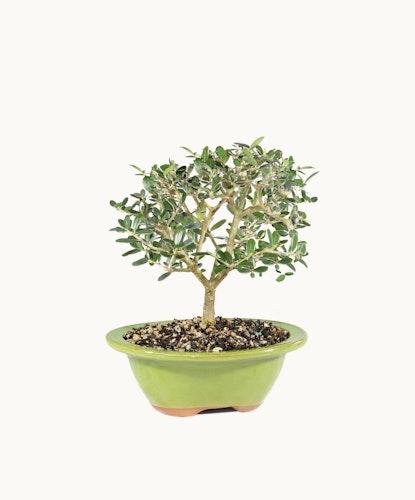Placement and Light. Indoor bonsai are tropical plants that are adaptable to indoor conditions. They may shed some foliage when first brought home, which is a normal part of the adjustment process. Place your tree in a sunny location, ideally near a southeast or west-facing window, to help it acclimate.
Watering. Proper watering is crucial for a healthy bonsai. You should water your tree thoroughly every two to three days, making sure water runs out of the drainage holes. Never let the soil completely dry out.
Repotting. Your bonsai will need to be repotted every four to five years, or when its root system becomes pot-bound. Repotting should be done during late spring or early summer using a specialized bonsai soil. Always wait at least one full growing season after purchasing your tree before repotting it.
Fertilizing. Bonsai need to be fertilized to stay healthy. Most water-soluble or time-released fertilizers work well when used as directed. For mature trees, a slow-releasing organic fertilizer is recommended.
Pests and Disease. Inspect your bonsai regularly for signs of insects or disease. Periodically spraying the trunk and foliage will help keep the tree clean. If you notice any problems, you can find treatment products at most garden centers.
Placement and Light. Indoor bonsai are tropical plants that are adaptable to indoor conditions. They may shed some foliage when first brought home, which is a normal part of the adjustment process. Place your tree in a sunny location, ideally near a southeast or west-facing window, to help it acclimate.
Watering. Proper watering is crucial for a healthy bonsai. You should water your tree thoroughly every two to three days, making sure water runs out of the drainage holes. Never let the soil completely dry out.
Repotting. Your bonsai will need to be repotted every four to five years, or when its root system becomes pot-bound. Repotting should be done during late spring or early summer using a specialized bonsai soil. Always wait at least one full growing season after purchasing your tree before repotting it.
Fertilizing. Bonsai need to be fertilized to stay healthy. Most water-soluble or time-released fertilizers work well when used as directed. For mature trees, a slow-releasing organic fertilizer is recommended.
Pests and Disease. Inspect your bonsai regularly for signs of insects or disease. Periodically spraying the trunk and foliage will help keep the tree clean. If you notice any problems, you can find treatment products at most garden centers.
Placement and Light. Indoor bonsai are tropical plants that are adaptable to indoor conditions. They may shed some foliage when first brought home, which is a normal part of the adjustment process. Place your tree in a sunny location, ideally near a southeast or west-facing window, to help it acclimate.
Watering. Proper watering is crucial for a healthy bonsai. You should water your tree thoroughly every two to three days, making sure water runs out of the drainage holes. Never let the soil completely dry out.
Repotting. Your bonsai will need to be repotted every four to five years, or when its root system becomes pot-bound. Repotting should be done during late spring or early summer using a specialized bonsai soil. Always wait at least one full growing season after purchasing your tree before repotting it.
Fertilizing. Bonsai need to be fertilized to stay healthy. Most water-soluble or time-released fertilizers work well when used as directed. For mature trees, a slow-releasing organic fertilizer is recommended.
Pests and Disease. Inspect your bonsai regularly for signs of insects or disease. Periodically spraying the trunk and foliage will help keep the tree clean. If you notice any problems, you can find treatment products at most garden centers.
Placement and Light. Indoor bonsai are tropical plants that are adaptable to indoor conditions. They may shed some foliage when first brought home, which is a normal part of the adjustment process. Place your tree in a sunny location, ideally near a southeast or west-facing window, to help it acclimate.
Watering. Proper watering is crucial for a healthy bonsai. You should water your tree thoroughly every two to three days, making sure water runs out of the drainage holes. Never let the soil completely dry out.
Repotting. Your bonsai will need to be repotted every four to five years, or when its root system becomes pot-bound. Repotting should be done during late spring or early summer using a specialized bonsai soil. Always wait at least one full growing season after purchasing your tree before repotting it.
Fertilizing. Bonsai need to be fertilized to stay healthy. Most water-soluble or time-released fertilizers work well when used as directed. For mature trees, a slow-releasing organic fertilizer is recommended.
Pests and Disease. Inspect your bonsai regularly for signs of insects or disease. Periodically spraying the trunk and foliage will help keep the tree clean. If you notice any problems, you can find treatment products at most garden centers.
Note: The blooming season is from April to June.
Note: The blooming season is from April to June.

